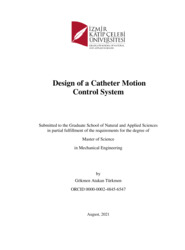Design of a catheter motion control system Kateter hareket kontrol sisteminin tasarımı
-
Eser Sahibi
Türkmen, Gökmen Atakan
- Tez Danışmanı Levent Çetin
-
Tür
Yüksek Lisans
- Yayın Tarihi 2021
-
Yayıncı
Graduate School of Natural and Applied Sciences
- Tek Biçim Adres https://hdl.handle.net/11469/2845
-
Konu Başlıkları
Kateter Ablasyonu - Metotlar
Catheter Ablation - Methods
ÖZETGeleneksel cerrahi yöntemlerinin riskli olması robotik teknolojisinin tıp alanında daha sık kullanılmasına sebep olmaktadır. Ameliyatlar sırasında hastanın vücudunda büyük kesikler açılmakta ve bu durum hastanın vücudunda kalıcı izler bırakabilmektedir. Vücut içindeki kanallara -mümkün olduğunda- kateter ile müdahale edilmesi ameliyatları minimal invaziv hale getirmektedir. Bu nedenle, tıbbi mühendislik uygulamalarında önemli olan konulardan biri de kateter sisteminin kontrol edilmesidir. Yaygın olarak kullanılan kateter sistemlerinin çoğu, cerrahlar tarafından kateterin iç kısımına yerleştirilmiş olan teller kullanılarak kontrol edilir. Bu kontrol stratejisi ile, istenilen pozisyon hassasiyeti elde edilmemekte hem de bu stratejinin uygulanması için uzmanlık gerekmektedir. Bu nedenle, otomatik kontrollü kateterler kullanılarak, cerrahi operasyonlarda yüksek doğruluk ve işlevsellik sağlamak istenilen bir yaklaşımdır. Bu tez kapsamında, tıp alanında kullanılan kateter sistemlerinin iki boyutlu uzayda hareket kontrolü ile ilgilenilmiştir. İlk olarak, kateter ucunun ilerlemesini ve yönlendirmesini sağlamak için iki eyleyici sistem tasarlanmıştır. Sürtünmeli tahrik sistemi kullanılarak kateter ilerlemesinin yüksek hassasiyetli kapalı döngü kontrolü yapılmıştır. Bu sistemin kontrollünde yeni bir kayan kipli denetleyici yöntemi kullanılmıştır. Kateterin yönelimini kontrol etmek için ise, kateterin uç kısmına milimetrik boyutlarda kalıcı mıknatıs yerleştirilmiştir. Bir temassız kalıcı mıknatıs eyleyiciyle, bu milimetre boyutundaki kalıcı mıknatısın konumu doğrudan ve de kateterin yönelimi dolaylı olarak değiştirilmiştir. Hareket kontrolü için geri besleme, makine görmesi sistemi ile sağlanmıştır. Bu üç sistem, Robot İşletim Sistemi kullanılarak eş zamanlı olarak çalıştırılmıştır. Kateterin hareket kontrol sisteminin performansı, üç boyutlu bronşiyal model verilerinin düzlemsel bir projeksiyonu ile elde edilen deneysel düzenek üzerinde doğrulanmıştır. Sonuçlar, önerilen kontrol metodolojisinin ve tasarlanan sistemin, kateteri kontrol etme yeteneğine sahip olduğunu göstermiştir.ABSTRACTDue to the risks of traditional surgical methods, the robotic technology has become more popular in the medical applications. Making large incisions in the patient's body may cause a permanent deformation on the patient during surgical operations. The surgical operations may become minimally invasive procedures by sending catheter systems to the channels in the body when possible. Apparently, one of the important key points in medical engineering is the control of the catheter system. The traditional catheter systems are controlled by surgical specialists using strings placed inside the catheter. This control strategy not only results in low positioning accuracy but also requires expertise to control. Besides, the catheter sizes became larger due to peripheral components. Therefore, automated control is a desired approach for providing high accuracy and versatility in catheter-based surgical operations. In this thesis, the motion control of the catheter system used in the medical field in 2D space is concerned. Firstly, two actuator systems were designed to advance the catheter and to guide of the catheter tip in body vessels or channels. The advancement of the catheter was controlled by a friction drive system in a closed-loop manner. A novel sliding mode control was proposed to control the drive system. A millimeter size permanent magnet was placed at the tip of the catheter tube to control the orientation of the catheter. An untethered permanent magnet actuator is used to manipulate the position of the millimeter size permanent magnet directly and the orientation of the catheter tube indirectly. The feedback for motion control was provided via machine vision setup. These three systems were operated synchronously using the Robot Operating System(ROS). The performance of the motion control system was verified with a test rig which is a planar projection of 3D bronchial model data. The results showed that the proposed control methodology and the designed system can control catheter motion.
-
Koleksiyonlar
ENSTİTÜLER
FEN BİLİMLERİ ENSTİTÜSÜ

 Tam Metin
Tam Metin

